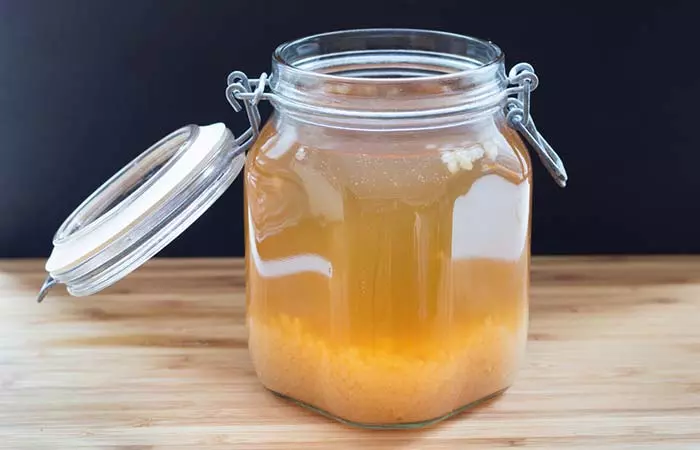Lactose Intolerance – Symptoms, Causes, And Treatment + Diet Tips
Keep an eye on the symptoms of this condition and learn the easiest ways to manage it.

Image: Shutterstock
Lactose intolerance affects about 65% of the world’s population, and it gets worse as individuals get older. This is a significant amount, which is why we need to learn more about this ailment and its consequences.
In this article, we will be discussing the home remedies for lactose intolerance and other related issues. Continue reading to know more.
In This Article
What Is Lactose Intolerance?
This is an intolerance to lactose, which is the sugar in dairy products (like milk). Some individuals don’t have enough of the enzyme lactase, which is required to digest this sugar and become intolerant to milk and milk products. But being lactose intolerant does not mean that you are allergic to milk.
 Did You Know?
Did You Know?Lactose intolerance can manifest itself in the form of the following signs and symptoms.
Signs And Symptoms Of Lactose Intolerance
If not managed in time, lactose intolerance may cause symptoms like:
- Stomach cramps
- Bloating
- Gas
- Diarrhea
- Nausea
- Frequent urination
- Vomiting
- Occasional constipation
- Lower belly pain
Lauren La Magna, a blogger, shares how she found out she was lactose intolerant. She mentions that she had a cheese and garlic pizza but felt sick. She felt discomfort in her lower stomach, cramp-like pain, and had to go to the bathroom again and again. This kept happening over many days, so Lauren started being careful with what she ate. She writes, “I cut out dairy for the day. I had zero stomach issues the next day. No indigestion. No loose stool…I had my annual physical that day and told my doctor of my sudden issues and she looked straight at me and said “that’s textbook lactose intolerance” (i).” She adds that the pain limited her ability to engage in essential daily activities and affected her overall well-being and productivity.
Lactose intolerance can be present at birth but usually occurs later in life as lactase enzymes become more depleted. Some people say that only infants and young children should drink milk and they have the enzymes to do so since these enzymes do diminish with age after about age 5. The condition has two different types, and the causes vary for each.
Types And Causes Of Lactose Intolerance
Lactose intolerance is classified into two types, depending on its causes. They are:
- Primary Lactose Intolerance
The most common type of lactose intolerance is caused by a decrease in the production of lactase in your body as you age – eventually leading to poor lactose absorption. Primary lactose intolerance can be partially caused by genetic factors because it is more prevalent in some populations than others. Surprisingly, Sweden’s population of lactose intolerant individuals is only about 4%. In the US, lactose intolerance varies by race with about 74% of African Americans, 87% of Indians, and 14% of Caucasians with some kind of inability to digest lactose.
- Secondary Lactose Intolerance
This type of lactose intolerance is more rare and usually short-lived. It may be caused by illnesses from a certain stomach bug or more serious conditions like Celiac diseasei A common condition that occurs due to an immune reaction to consuming gluten and leads to symptoms like diarrhea and bloating. . It can also result from the inflammation of your gut wall – as this temporarily reduces lactase production.
Many individuals are unaware of being lactose intolerant until they get themselves tested. Following are a few diagnostic tests that will help.
Lactose Intolerance Diagnostic Tests
There are three major tests that help diagnose lactose intolerance. They include:
- Lactose Tolerance Blood Test – It also involves observing your body’s reaction to high lactose levels. Two hours post consuming a high-lactose diet, your blood is measured for glucose levels. The glucose levels must ideally rise. Unchanged glucose levels indicate that your body is unable to digest lactose.
- Hydrogen Breath Test – This test also requires you to consume a high lactose diet. Your doctor will check your breath at regular intervals for the amount of hydrogen released. For normal individuals, the amount of hydrogen released will be very low as compared to those who are lactose intolerant.
- Stool Acidity Test – This test diagnoses lactose intolerance in infants and children. Undigested lactose gets fermented and produces lactic acid, which can be easily detected along with other acids in the stool sample.
These tests will also help confirm if you are suffering from lactose intolerance alone or are allergic to dairy as well. There is some confusion between the two, which is what we have addressed in the next section.
Dairy Allergy Vs. Lactose Intolerance
These terms may sound similar, but there are differences.
Lactose Intolerance
- Caused by the lack of the lactase enzyme responsible for digesting milk sugar (lactose).
- Can develop at any stage of your life.
- Can also be caused by faulty genes or an infected and damaged small intestine.
- Occurs naturally with age and is more common in the older lot.
- More common in certain populations than others. See demographics above.
Milk Allergy
- Caused by an allergy to milk proteins – mostly casein.
- Usually develops in the early stages of one’s life.
- A result of a malfunctioning immune system that attacks milk proteins.
- More common in infants and children but may surface at other ages as well.
- The most common type of food allergy among children.
Now that you know the differences, let’s look at the foods that may aggravate lactose intolerance.
Foods That Aggravate Lactose Intolerance
Lactose intolerant individuals must avoid:
- Milk from cows, goats, or even sheep
- Dairy products like cream, cheese, yogurt, etc. However, there are low lactose cheeses that you may be able to tolerate every 3 days. These include: Brick cheese, Cheddar, Colby,
- Dry-curd cottage cheese, Gruyère, Havarti, Manchego, Provolone, and Swiss cheese.
- Other foods made with dairy, including chocolates, cakes, cereals, bread, instant foods, and processed meat like ham
Most of these foods are rich in calcium, so avoiding them can mean lowering your calcium intake. Hence, you must supplement calcium in your diet by finding substitutes for dairy products. The following foods are your solution to get enough calcium in your diet, without causing complications.
References
Articles on StyleCraze are backed by verified information from peer-reviewed and academic research papers, reputed organizations, research institutions, and medical associations to ensure accuracy and relevance. Read our editorial policy to learn more.
Non-dairy sources of calcium-rich foods include:
- Spinach
- Salmon and sardines (with bones)
- Orange juice fortified with calcium
- Broccoli
- White tuna
- Soy milk
- Green leafy vegetables
- Almonds
- Bone broth
- Oats
- Fennel seeds
- Cinnamon
- Slippery elm
- Flaxseed
- Chia seed
- Amaranth
- Millet
- Sorghum
- Arrowroot
- Potato starch
- Coconut Flour
Other foods like licorice, ginger, marshmallow root, psyllium husk, and turmeric may be included to help soothe your digestive tract. Also, going gluten-free and including food items like rice flour, dairy-free quinoa, tapioca, cornstarch, buckwheat allow your body to rest and heal, which may help you with lactose intolerance. Once you fix your diet and nutrition, you can start following natural remedies that help treat your condition.
Natural Remedies To Treat Lactose Intolerance
- Vitamins
- Apple Cider Vinegar
- Essential Oils
- Eggs
- Lemon Juice
- Aloe Vera Juice
- Kombucha
- Kefir
- Bone Broth
- Coconut Oil
- Lactase Enzyme Supplement
- Lactaid Milk
Home Remedies To Treat Lactose Intolerance
1. Vitamins
Individuals with lactose intolerance are often deficient in vitamins B12 and D (1). Hence, you must obtain these vitamins from sources other than dairy.
Foods rich in these vitamins include fatty fish, fortified orange juice, soy milk, egg yolks, and poultry. You can also take additional supplements, after consulting a doctor.
2. Apple Cider Vinegar
You Will Need
- 1 tablespoon of apple cider vinegar
- 1 glass of warm water
What You Have To Do
- Mix a tablespoon of apple cider vinegar in a glass of warm water.
- Drink the mixture.
How Often You Should Do This
You must follow this remedy at least once a day.
Why This Works
Apple cider vinegar turns alkaline once it enters your stomach and neutralizes the stomach acids, aiding digestion of dairy sugar. This helps prevent symptoms like gas, bloating, and nausea.
3. Essential Oils
a. Lemon Essential Oil
You Will Need
- 1 drop of lemon essential oil
- 1 glass of cold water
What You Have To Do
- Add a drop of lemon essential oil to a glass of cold water.
- Mix well and drink.
How Often You Should Do This
You must drink this once daily.
Why This Works
Lemon essential oil aids digestion by neutralizing stomach acids, thereby relieving digestive problems caused by lactose intolerance (2).
b. Peppermint Oil
You Will Need
- 1 drop of peppermint oil
- 1 glass of water
What You Have To Do
- Mix a drop of peppermint oil in a glass of water.
- Drink the concoction.
How Often You Should Do This
You must drink this at least once daily.
Why This Works
Peppermint oil soothes your digestive functions. It aids digestion and relieves bloating and gas (3).
4. Eggs
You Will Need
2 eggs
What You Have To Do
- Either hard boil two eggs or cook them in any other preferred way.
- Consume them.
How Often You Should Do This
You must consume 2 eggs daily.
Why This Works
Avoiding dairy products can lead to a deficiency of calcium and vitamins D and B12. Consuming eggs daily can compensate for this (4), (5).
5. Lemon Juice
You Will Need
- ½ lemon
- 1 glass of water
- ½ teaspoon honey
What You Have To Do
- Add the juice of half a lemon to a glass of water.
- Mix well and add honey.
- Consume the lemon juice.
How Often You Should Do This
You must drink this once daily.
Why This Works
Lemon juice, though acidic, turns alkaline once metabolized. This action has a neutralizing effect on stomach acids, alleviating gas, bloating, and nausea (6).
6. Aloe Vera Juice
You Will Need
½ cup of aloe vera juice
What You Have To Do
Consume half a cup of fresh aloe vera juice daily.
How Often You Should Do This
You must drink this 1 to 2 times daily.
Why This Works
Aloe’s anti-inflammatory properties help soothe your disturbed stomach. Aloe vera also restores your stomach’s pHi A chemical scale that measures the number of hydrogen ions present in a substance and helps identify its state of acidity or basicity. balance, thanks to its magnesium lactate composition (7).
7. Kombucha
You Will Need
1 glass of kombucha
What You Have To Do
- Consume a glass of kombucha daily.
- You can either drink store-bought kombucha or make kombucha tea at home (you just have to steep the tea bags in hot water).
How Often You Should Do This
You must drink this once daily.
Why This Work
The probiotics in kombucha (fermented black or green tea) restore healthy gut flora, which supports gut functioning. Probiotics also have a beneficial role to play in relieving symptoms of indigestion associated with metabolic disordersi A group of conditions that affect the metabolism of the body, leading to the risk of stroke and type 2 diabetes. like lactose intolerance (8), (9).
8. Kefir
You Will Need
1 cup of water or dairy-free kefir
What You Have To Do
Consume a cup of kefir water (dairy-free).
How Often You Should Do This
You must drink this at least once daily.
Why This Works
Kefir is one of the richest sources of probiotics. As discussed, probiotics aid digestion of lactose and enhance gut health in a powerful way (10). Kefir can be made from dairy but the bacterial culture used to make kefir helps digest lactose.
9. Bone Broth
You Will Need
8 to 12 ounces of bone broth
What You Have To Do
Consume 8 to 12 ounces of freshly prepared bone broth.
How Often You Should Do This
You must drink this once daily as a part of your diet.
Why This Works
Bone broth contains calcium, which is a nutrient lactose intolerant individuals could be deficient in. Bone broth also contains gelatin and collagen that helps your gut handle lactose better (11).
10. Coconut Oil
You Will Need
Coconut oil (as per requirement)
What You Have To Do
Replace butter with coconut oil in your diet.
How Often You Should Do This
You must do this daily.
Why This Works
Coconut oil is dairy-free and makes for a perfect lactose-free diet. Regular intake of coconut oil soothes your stomach as well (12).
11. Lactase Enzyme Supplement
You Will Need
Lactase enzyme capsules or tablets
What You Have To Do
Consume lactase enzyme supplements after consulting your doctor.
How Often You Should Do This
Take the supplements as per the directions provided by your physician.
Why This Works
Lactase enzyme supplement facilitates the absorption of calcium in those with lactose intolerance (13).
12. Lactaid Milk
You Will Need
Lactaid milk
What You Have To Do
Consume lactaid milk.
How Often You Should Do This
Consume it based on your doctor’s recommendation.
Why This Works
Lactaid milk helps to make up for lactase deficiency often brought about by lactose intolerance and aids the absorption of calcium.
 Did You Know?
Did You Know?You may also try certain medications to manage your lactose intolerance. Learn more about it in the next section.
Medication For Lactose Intolerance
The primary treatment for lactose intolerance involves over-the-counter supplements that provide the enzyme lactase, which the body lacks. These lactase supplements are usually taken before consuming dairy products to help break down lactose, thus reducing symptoms like bloating, diarrhea, and abdominal pain (14). Some people also benefit from probiotics that introduce beneficial bacteria in the gut to potentially improve lactose digestion over time (15).
While medication can be effective in managing lactose intolerance, dietary modifications are recommended alongside these treatments. Those with this issue should reduce or eliminate dairy products and opt for lactose-free alternatives to improve their quality of life. Consult a healthcare professional to determine the most appropriate dosage and treatment plan for severe cases of lactose intolerance.
Infographic: Lactose Intolerance: Symptoms, Diagnosis, And Remedies
Lactose intolerance commonly affects many people. As milk and dairy products make up a major part of many people’s regular nutrition, this condition can pose a serious challenge. Being mindful of what you eat is one important step to ease this condition. In the infographic below, we have highlighted some key points about this condition. Take a look.

Illustration: StyleCraze Design Team
Lactose intolerance is quite prevalent in people all over the world, courtesy the absence/depletion of an enzyme that breaks down lactose. This condition cannot be treated; however, you can certainly relieve digestive problems that follow lactose intake. Home remedies for lactose intolerance, like apple cider vinegar, lemon essential oil, peppermint oil, lemon juice, aloe vera juice, etc., aid digestion and help relieve symptoms of indigestion, like gas and bloating. The easiest way to combat lactose intolerance is to take lactase supplements; however, you should not take them without consulting your doctor.
Frequently Asked Questions
What kind of milk is good for lactose intolerance?
If you are intolerant to lactose, you can replace dairy with lactose-free milk such as soy milk, almond milk, coconut milk, rice milk, or Lactaid milk, which is milk supplemented with lactase enzymes.
How is the body affected by lactose intolerance?
Symptoms of lactose intolerance surface when the cells in the small intestine do not produce enough enzymes to break down lactose. As a result, lactose is not absorbed by the body. Instead, it moves into the large intestine, where it is fermented by bacteria, leading to gas and bloating.
How long does it take to get dairy out of your system?
It may take anywhere between 10 days to 3 weeks to get any dairy protein out of your system. Post this, your symptoms will cease on their own.
Can you eat pizza and chocolate if you are lactose intolerant?
Both pizza and milk chocolate contain lactose. Even though cheese is easy to digest, individuals with a severe intolerance to lactose must steer clear of these foods.
How much milk is safe for lactose intolerant people?
Lactose intolerant individuals can generally tolerate up to 1 cup of milk (12 grams of lactose). However, this is specific to the individual. One has to begin with a small amount and gradually work it up if they don’t see any side effects. Also, you should only eat or drink dairy products every 3 days so you don’t build up further intolerance.
How long does lactose intolerance pain last?
The symptoms of lactose intolerance may last up to 48 hours or until lactose passes through the digestive system.
How can I stop lactose intolerance pain immediately?
It is best to take over-the-counter medicines to ease lactose intolerance symptoms immediately.
Does tea help lactose intolerance?
It may help. Studies found that tea extracts may reduce lactose content (16). Herbal teas like chamomile tea may help manage lactose intolerance due to its ability to neutralize stomach acids and reduce stomach cramps (17). However, further studies are required to substantiate the claim.
Why am I suddenly lactose intolerant?
Sudden lactose intolerance may be caused when the small intestine decreases lactase production after an illness, injury, or surgery involving your small intestine.
Key Takeaways
- Lactose intolerance occurs when the body cannot digest lactose or the main sugar in dairy products.
- Natural remedies for lactose intolerance may relieve digestion problems.
- Avoid dairy products and foods made with dairy including chocolates, cakes, and processed meat.
- Pick alternatives to dairy products like spinach, broccoli, and soy milk to maintain the calcium intake in your diet.

Image: Stable Diffusion/StyleCraze Design Team
Personal Experience: Source
StyleCraze's articles are interwoven with authentic personal narratives that provide depth and resonance to our content. Below are the sources of the personal accounts referenced in this article.
i. Lactose Intolerant at 20https://laurenlamagna1.medium.com/lactose-intolerant-at-20-9ea3623fd013
References
Articles on StyleCraze are backed by verified information from peer-reviewed and academic research papers, reputed organizations, research institutions, and medical associations to ensure accuracy and relevance. Read our editorial policy to learn more.
- 1. “Vitamin B12 in meat and dairy products” Nutrition Reviews, US National Library of Medicine
2. “Effects of limonene and essential oil from Citrus aurantium on gastric mucosa: role of prostaglandins and gastric mucus secretion” Chemico-Biological Interactions, US National Library of Medicine
3. “A Novel Delivery System of Peppermint Oil Is an Effective Therapy for Irritable Bowel Syndrome Symptoms” Digestive Diseases and Sciences, US National Library of Medicine
4. “Vitamin B12 bioavailability from egg yolk and egg white: relationship to binding proteins” The American Journal of Clinical Nutrition, US National Library of Medicine
5. “THE VITAMIN D CONTENT OF EGG YOLK” Canadian Medical Association Journal, US National Library of Medicine
6. “Quantitative Assessment of Citric Acid in Lemon Juice, Lime Juice, and Commercially-Available Fruit Juice Products” Journal of Endourology, US National Library of Medicine
7. “The Effect of Aloe Vera Clinical Trials on Prevention and Healing of Skin Wound: A Systematic Review” Iranian Journal of Medical Sciences, US National Library of Medicine
8. “Current evidence on physiological activity and expected health effects of kombucha fermented beverage” The Journal of Medicinal Food, US National Library of Medicine
9. “Sequence-based analysis of the bacterial and fungal compositions of multiple kombucha (tea fungus) samples” Food Microbiology, US National Library of Medicine
10. “The effects of probiotics in lactose intolerance: A systematic review” Critical Reviews in Food Science and Nutrition, US National Library of Medicine
11. “Functional and bioactive properties of collagen and gelatin from alternative sources: A review” Food Hydrocolloids, Elsevier
12. “Anti-inflammatory, analgesic, and antipyretic activities of virgin coconut oil, Pharmaceutical Biology, US National Library of Medicine
13. “Management and treatment of lactose malabsorption” World Journal of Gastroenterology, US National Library of Medicine
14. “Effect of lactase on symptoms and hydrogen breath levels in lactose intolerance: A crossover placebo-controlled study” Journal of Gastroenterology and Hepatology Foundation
15. “Effects of probiotics administration on lactose intolerance in adulthood: A meta-analysis” Journal of Dairy Science
16. “Medicinal Use of Camellia sinensis on Lactose Intolerance,” Journal of Biological Sciences, Science Alert
17. “Chamomile: A herbal medicine of the past with bright future” Molecular Medicine Reports, US National Library of Medicine
Learn about the causes, symptoms, diagnosis, treatment, and pathology of lactose intolerance in this informative video. Know the facts and understand how to manage this condition.
Read full bio of Sarah Spann
Read full bio of Arshiya Syeda
Read full bio of Moksha Gandhi




































